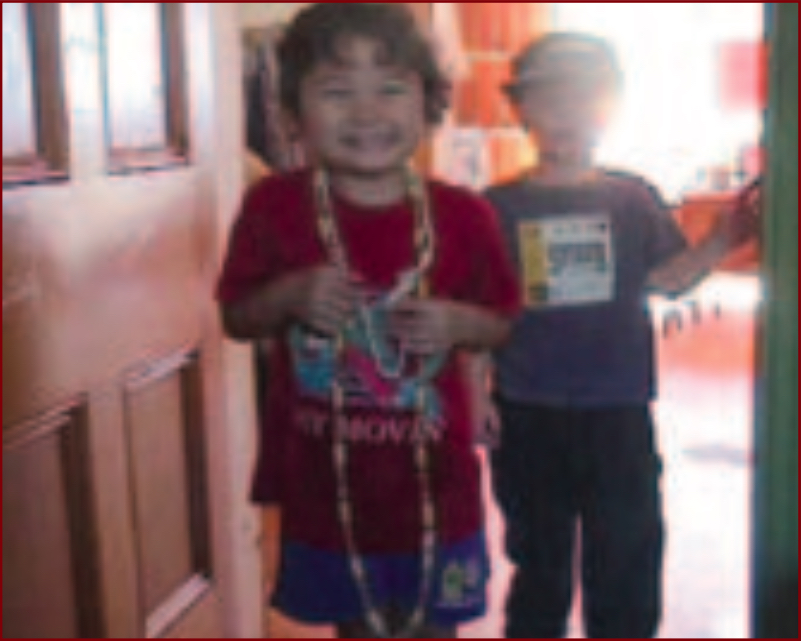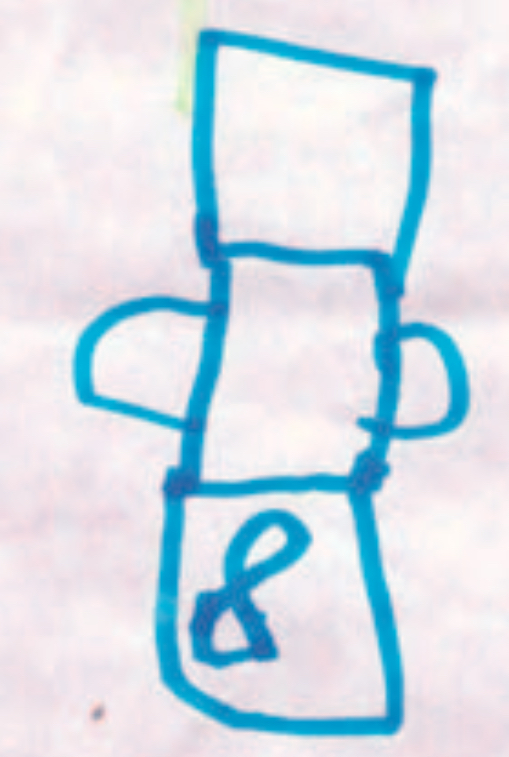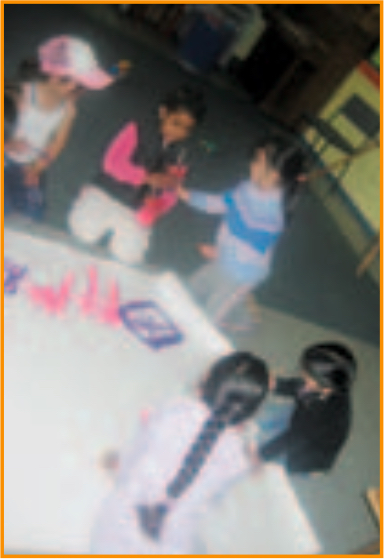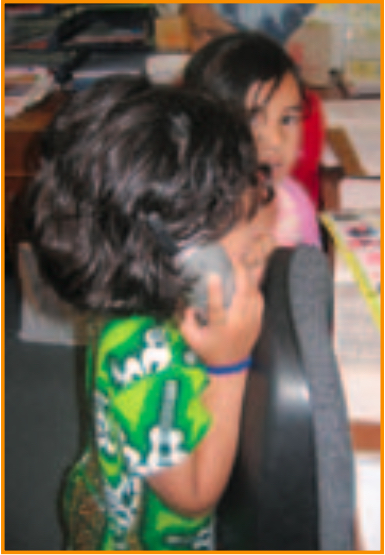Kei Tua o te Pae
Kei Tua o te Pae/Assessment for Learning: Early Childhood Exemplars is a best-practice guide that will help teachers continue to improve the quality of their teaching.
The exemplars are a series of books that will help teachers to understand and strengthen children's learning. It also shows how children, parents and whānau can contribute to this assessment and ongoing learning.
We are making improvements to our download-to-print functionality. So if you want a printed copy there are PDF versions available at the bottom of the main cover page.
Learning with and alongside others
-
Developing friendships
10 February
Zalaluddin is a Malaysian boy, Sajed is from Afghanistan and Art is from Kosovo. They are good friends and take care of each other.
Sajed and Zalaluddin were driving the truck. They left Art behind and Art was looking unhappy. I asked him, “What is the matter?”
He said, “I like to play with them and drive the truck. They do not want to have company.”
I asked him if he would like to have another truck and play with it but he wasnʼt happy about it and said, “No no no! I like to play with Sajed and Zalaluddin.”
I called Zalaluddin and Sajed.
“Hey guys, you missed out your friend Art. Would you like Art to join you?”
They reversed their truck to us and said to Art, “SORRY!”
It was amazing to me how they understand how he feels and their apology to Art was very polite.
This story shows the friendship and how the children cope with each other even when these children are from different countries with different cultures and different languages.
Zohra
17 February
Noticing
Zohra has written a learning story about three children: Zalaluddin, Sajed and Art. They were able to sort out a problem that involved sharing, good manners and respect for each other.
Zohra noticed all these things and wrote the friendship story. We decided at our planning meeting that there are everyday examples in our centre of childrens' caring behaviour towards one another and friendships even though they often do not have a common language or culture. Their life experiences are extremely varied. Nevertheless, they want to have friends and they want to help adults and each other.
Recognising
Zohra was able to support the boys to include their friend by talking to them and listening carefully to them with respect and sensitivity. She recognised that the children are kind and considerate towards each other.
Human relationships are an important part of life. All staff have examples of children making friends and helping teachers. Some children help each other, help teachers and help themselves. We want to reinforce this behaviour and support children to develop relationships in our democratic centre.
Responding
We want to be aware when children are helping one another, making friends and encouraging each other and adults to be inclusive and democratic.
We are all learning together.
-
Mahdia’s story
-
On Monday afternoon the children were playing outside in the playground. Hadi arrived at the family centre and was happy to see his friends. He gave Shukrullah and Maryam a ride in the wagon.
Suddenly Mahdia came outside. She came over to them and showed them her arm. They began talking together in their common home language, Dari.
She showed them her plasters on her hand and inside her elbow. Their faces changed. They wanted to see closely and as she talked their faces became full of concern. I wondered what they were saying and assumed that Mahdia was telling her friends about her blood tests of this morning – about how the doctors and nurses could not find a vein and how she will have to return to hospital again tomorrow for another try.
The children were very concerned and even in the middle of playing they stopped and showed that they cared.
I was amazed and overwhelmed by their caring attitude.

Our children have knowledge of medical procedures, often ongoing ones such as in Mahdia’s case. They have all experienced blood tests and know exactly what Mahdia is talking about and showing them. They are brave and understanding of one another.
Geranesh.
16 June
-
-
Blocks and beads
-

Micah and Jak had built a construction with blocks and then added treasure. Suddenly Micah left, followed by Jak, who then returned and with great delight slid into the construction and it collapsed. Micah came in and was very disappointed. Jak said to him, “It’s okay – we will build another one,” and they did.

This time they began with the beads and the blocks together from the beginning and they included the beads as they built it in a very clever way. Micah had a beautiful golden buckle and puzzled as to how he could stand it up on the block. It took him a while to figure it out. Suddenly he told Jak that he wanted to place it under a certain block so that it would stick out. Jak disagreed and carried on building and then he stopped, looked at Micah, lifted up the exact block that Micah had indicated and said “There you are, Micah!” (I just love it when they listen to each other and change their ideas to accommodate their friend’s ideas.)

David came along and he watched them for a while and I could see that he wanted to join in and wasn’t sure how to. With a little bit of encouragement David asked Micah which necklace he could have. Micah looked at them all and handed him one. Well, David just beamed and went off to look in the mirror. Then Jak ran to the doorway asking where David was and called to him and gave him a beautiful necklace too. How wonderful to see this generosity and willingness to share. I loved the way Jak took the lead from Micah and gave David a necklace too.
Short-term review
This is a long story and quite a complex one. I recorded it because it tells so much about Jak and Micah’s friendship and their developing empathy and inclusion of other people in their play. I was so impressed to see that they were able to keep the focus of the building project despite the other things going on. Their block building skills continue. Jak practises and practises balancing the blocks and changing the style of his buildings. He loves to introduce new material into his building.
-
-
The three friends
-
Parent’s voice
Tane has had an on-going enthusiasm for sewing projects following a session at kindy where he used a needle and thread for the first time. With his “MumMum” [grandmother] he made a bag with button decorations and last week he made an apron ... The biggest challenge was coming to grips with having to finish each seam with some kind of knot to keep it all together.
Child's name: Sarah
Date: 22 June
Teacher: Lesley
A Learning Story
Belonging
Mana whenuaTaking an Interest Sarah and Tane were together when Tane began to discuss his sewing experiences. Sarah was keen to pursue the idea of sewing and we went into the storeroom to find some material. Initially the idea was that Sarah would make an apron (Tane’s idea) but Sarah had other thoughts!
Sarah wanted to make a board with material over it and she would put pieces of paper on it!
Sarah chose her material and we used the sewing machine to attach the pieces of material together. Sarah arranged the material on the board and I used the staple gun to attach it to the board.
Sarah wanted to make a sign that said, “No shoes allowed in my room,” to go on the board. Sarah copied the words that I had written and then she illustrated her notice. We stapled the notice onto the noticeboard. Sarah read the notice to Tane and later on showed the group her board and read them the notice.
Well-being
Mana atuaBeing Involved Exploration
Mana aotūroaPersisting with Difficulty Communication
Mana reoExpressing an Idea or a Feeling Contribution
Mana tangataTaking Responsibility Short-term review
Sarah pursued her interest throughout the morning session. (Te Whāriki, Belonging, Well-being)
She persisted with her task and thought about ways to follow through with her idea. (Te Whāriki, Exploration)
Sarah communicated her design ideas clearly with a small group and the large group. (Te Whāriki, Communication)
Sarah contributed to the programme, sharing her ideas. (Te Whāriki, Contribution)
What next?
Continue to develop and extend opportunities for Sarah to pursue other sewing projects. Maybe we could use some sewing patterns to make clothing?



Tane and Sarah discussing their ideas about the type of fabric they could use for sewing.
Child's name: Sarah
Date: 22 June
Teacher: Lesley
Learning story
Tane walked into kindergarten this morning and said “Lesley, I want to make an ambulance jacket!” “Oh, how do you think you are going to make it – what about making a pattern of your ideas?” “I already have,” said Tane. “Here’s the pattern and here is where the holes for the arms and the head are.” Tane showed me his picture, which showed a “bird’s-eye” perspective of the jacket he loves to wear at kindergarten.

Leon said, “I’m going to make a police jacket,” and drew his pattern showing the same view as Tane. The pattern showed the hole for the head and the arms. Sarah was also interested in making a jacket and decided to make an ambulance jacket too. The three children began to discuss who would be first to sew their jacket. “I’m first,” said Tane, “and you’re second, Leon, and you’re last, Sarah.” Sarah very quickly replied, “Tane said I’m last but I’m not, I’m third!”
Tane found the kindergarten jacket they were wanting to model their one on, and we placed it on a sheet of paper to draw around it. They each had a turn of drawing around the jacket and making a paper pattern. The pattern was then placed on the calico and cut out. They wanted words on their jackets (like the kindergarten one) so I got the fabric pens and they drew their designs on the front and the back. Leon drew maps on his police jacket and he wanted me to write the words “This is a police jacket with maps on it”. Tane and Sarah drew ambulances.
Tane said to Sarah, “Can I have the red pen because the light’s off (on the ambulance), cos there’s no red on it – I need the red so the light can go.” He described in detail who was in the ambulance. “The patient got shot and that person – that’s my arm driving, I’m the driver.” Sarah said, “That’s my mum, that’s Harriet [sister] and Dad is the patient. I’m the driver. I was driving to my house. I knocked on the door and said ‘Come on, let’s go and get Dad,’ so Mum, Harriet and me drove away to where Dad had crashed!” When they had finished their drawings, they each had a turn ironing the fabric – we talked about the importance of ironing it to prevent the patterns from washing out. The next stage was to sew the jackets. Tane’s was sewn first. He controlled the foot pedal in response to my “stop” and “go” directions. He was very pleased with the result and put it on immediately! Leon and Sarah had to wait until the next day as we ran out of time!
Sewing project continued - 21 August
Today it was Leon and Sarah’s turn to have their jackets sewn. Aileen set up the machine and off they went. The jackets were completed and proudly worn. They then decided “ambulance trousers” would look good! “We haven’t got a pattern for that,” I said. “Maybe your mum has, Sarah.” We then thought about what else they could make and the idea of a bag came up. So they each decided what size bag they wanted and I cut the calico to size. Sarah and Tane wanted a big bag and Leon wanted a very small bag. They drew their designs, ironed them and lovely Aileen sewed them with the children’s help! The bag making triggered interest from many others and so the bag factory began.
Short-term review
The sewing interest was reintroduced into the programme with the jacket-making idea. This interest has been evident for some months.
T, S, and L focused on their project for a long period of time. (Te Whāriki, Belonging, Well-being)
They were familiar and confident in the concept of using a sketch to visualise their ideas and then transfer that into the item in mind using another media (fabric).
Mathematical links were evident in the connection made with the sketched drawing to the object, the drawing showing spatial awareness. (Te Whāriki, Exploration)
Literacy was utilised in a meaningful way (the writing on the jackets representing their purpose). (Te Whāriki, Communication)
Their interest triggered interest from others, which expanded into other ideas. (Te Whāriki, Contribution)
What next?
Being prepared and alert to other possibilities from the group!


Parent's voice
Sarah came home from kindy saying “We have to make trousers, we don’t have a pattern at kindy!” We went through the sewing box and found a pattern and fabric – it had to be enough to make 3 pairs for “the team”. Sarah told me how we cut the fabric with “big” scissors and how we needed to draw around the pattern first.
Between us, we made the trousers – Sarah helping with the machine – comparing our machine to the kindy one.
The next day Sarah took her pattern, instructions and the extra fabric to kindy to give to the teachers to make the extra 2 pairs of trousers. Sarah wore her trousers to kindy for the rest of the week along with the vest and bag that she’d made at kindy.

The three friends in their latest designs
-
-
A business venture part 1
-

Proposal presented by Kirstlee, Kelan and Shava
Proposal
To set up a lemonade/juice stand and sell juice to customers.
Target market
Customers (People who pass by the kindergarten)
Action plan
- Decide what juices to sell.
- Design juice stand.
- Name the stand.
- Decide on where we will get the fruit from for the juices.
- Decide on cost of juice.
- Promote our product to potential customers.




Designing the tablecloth
The design team set to work on the tablecloth under Kirstlee’s supervision and instructions. Their brief: The colours to be pink and purple only and the design to be floral!
The planning stages
The girls plan and design the stand, setting the price at 50 cents per cup. Shavaughan suggests a trial run with a pretend juice stand!!
They promote their proposal at mat time to other children and to parents, chatting to them and organising people to bring in bags of fruit to enable them to begin production the following day.
The girls organise Judy to bring in her juice machine.
Kirstlee sets to work on the laptop making the signage “Kirstlee’s Lemonade/Juice stand. 50 cents a cup.”
Kirstlee decides on the name without a challenge from the other two girls!!!


Production begins



Production begins with a strong team of willing and eager workers. Oranges, bananas, apples, carrots, pineapples and heaps of tangelos (thanks to Tamara and Andy’s dad) are peeled and sliced, and a “mixed juice” is decided upon for promotion on the first day of business.
Open for business


The lemonade/juice stand is set up. Tables are resplendent in their floral tablecloths and the girls are ready and eager to attract any passers by. Business is booming and they are “SOLD OUT” in all of 20 minutes.
Customer satisfaction

Customers declared the product to be “yummy” and “delicious” and a production run was set for the following day!

Profit margins Kirstlee counts the takings after 3 days of production and the addition of muffins to the product range. Their profit – a tidy $154.00!!!
Evaluation
It was wonderful to see an idea flow from a conversation that I had with the girls. Their ideas were very definite and they were always confident that they would work.
Although they were the initiators and often took charge in certain situations, it was great to see how so many other children and parents came on board and supported their ideas and plans.
In one way or another the majority of the morning session children and parents were involved in their business venture, whether it be supplying fruit, working as part of the design or production team or simply as satisfied customers!!
-
-
A business venture part 2
-
Short-term review/What next?
As they worked on their business venture, the children were developing a number of important skills. They were developing their awareness of literacy as they were writing their signs and developing the planning stages of their project. Their mathematical skills were extended as they calculated their money and counted their profits!! They were estimating quantity when they were working out how much fruit they needed to use and we focused on healthy eating as we promoted their products.
They discovered that making their project a success required perseverance, teamwork, co-operation and patience!!
I wonder now girls, how and what you will decide to do with your profits?
Decisions to be made

After browsing through many different catalogues the girls decide that their profits should be spent on the purchase of three dolls and a selection of clothes and shoes!!
Placing their orders



The girls ring Rachel at Play ’N’ Learn and place their orders. They give her their names and the kindergarten address so that she can despatch the parcel as soon as possible.
The rewards of a great business venture


Smiles of satisfaction from the girls as they see a tangible result after all their hard work.
New dolls for the kindergarten!!
-
-
The artists
Children: Zach, Gabriel, Ivie, Nikita
10 June
Today was such a beautiful day that Jo moved the painting outside. This soon became a very busy activity as the children came over to see what was happening and got involved. We were using cotton buds as our paintbrushes, which took a lot of skill and concentration.
Zach was the first on the scene. Jo gave him a cotton bud, which he very carefully held onto in the middle and dipped in the paint then watched as he made lines and squiggles on the paper.
Just then Nikita came to join the fun. “What you doing?”, “Why?”, “What’s that?” were among the many questions that came with Nikita. As I tried to answer her questions she moved alongside Zach’s painting and started shaking glitter over it. Luckily Zach was okay with this and eagerly watched what Nikita was doing.
After watching the other children for a while, Ivie and Gabriel got stuck into painting with their cotton buds, both delicately holding the cotton bud at the end and dipping it in the paint.
Gabriel decided to try every colour available and moved the cotton bud around in squiggles while Ivie seemed to like the colour green and drawing straight lines on the paper.
What learning is happening here?
The most important learning that happened here was through the social interaction. One of the goals in Te Whāriki suggests the importance of an environment where children are encouraged to learn with and alongside others. This develops skills for friendship such as turn taking, problem solving and thinking about the other person’s feelings. Nikita and Zach worked well together with Nikita taking on the role of helping and showing Zach what to do. Although Ivie and Gabriel didn’t verbally communicate with the other children, they did watch and copy what the others were doing and it is important to be able to enjoy solitary play as well. The children are also experimenting with different painting objects and gaining confidence with the processes of art and craft.
Te Whāriki also suggests the importance of an environment where children can discover and develop different ways to be creative and expressive.
What next?
We will continue to provide these important social activities so the children have opportunities to develop friendships and the necessary skills that are involved in working alongside others.
Most children find painting very exciting and are often queuing up to be involved, so it’s important to have it available as often as possible and to introduce new painting objects to get the children thinking and learning while still having lots of fun.
-
Issy’s new role
-
Teacher: Jo
We have a new primary caregiver within the centre.
Welcome to Issy. Issy’s new role is taking responsibility for our young friend Jimmy who is five months old. Sitting comfortably in his chair, he had not long had his bottle when he began growling with a windy tummy. Issy heard this and went over to see if he was okay. She lent a hand by rocking his small chair back and forth and he soon smiled at her. She’d noticed he’d had a spill. Issy moved towards the kitchen sink, grabbing a flannel and back to Jimmy. She wiped his face.
I saw this and both Jimmy and Issy were smiling at each other.
The learning that happened
Issy is role-modelling the evidence she has observed whilst being out in our infant room. Jimmy doesn’t mind. He confidently shares a smile with everyone so for him Issy is another friendly face. Issy suits this role as she has been using these techniques on her dolls and is now putting this experience into practice with Jimmy.
Teacher’s reflection
I observed Issy attending to her “new role” as a primary caregiver at the centre. Issy showed confidence in her responsibility towards young Jimmy, making sure that his emotional well-being was nurtured. She was being sensitive, and in tune with him, open to his needs and able to interpret them correctly. These exchanges are an integral part of interactions that foster secure attachment.
Adults have an important role to play in encouraging, supporting and challenging young children as they construct understandings about their world, the events, the people and objects in it.
Children take on teaching roles by role-modelling the practices that they have observed.
Children’s learning and development are the result of interactions between children and their environments. This can happen by allowing children free movement between the environments where they choose to explore either indoors or out.

A key quality indicator is responsive caregiving, which helps to ensure that trust is built and maintained between our infants and their teachers. Our teachers interact with infants in a way that includes them in any decisions that are made.
We do this through attentive listening to children’s cues and modelling language. The caregiver takes on a role in which certain responsibilities are practised to ensure that there is responsive caregiving occurring.
We are all interested in “continuity” and it is so very satisfying to review these photos of Eden and Issy just over a year ago. Eden was fascinated with Issy and we watched with awe at the close attention and sustained interaction as these two worked on building a relationship.
Excerpt from original learning story


“Eden especially developed a special bond with Issy and Issy is more than happy with Eden’s beautiful singing and chatting and ever so gentle tickling. This particular day Eden stayed with Issy for over an hour, talking, singing and tickling and Issy responded with huge smiles and gurgling.”
And now ... Issy takes this role with Jimmy. A rhythm, not a timetable, enables our tiny babies and toddlers to have a great deal of choice throughout the day. Rigid time fragmentation stifles investigation. Full attention supports working out what questions babies ask. This day Issy proved this to us.
-
